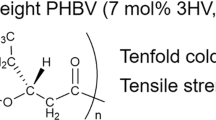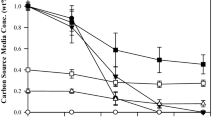Abstract
Films were prepared from 2% solutions of biodegradable poly-3-hydroxybutyrate [P(3HB)] and investigated. The polymer was synthesized by the Cupriavidus necator B-10646 bacterium cultivated using various carbon sources (glucose and glycerol of different degrees of purity, containing 0.3 to 17.93% impurities). Glycerol as the substrate influenced molecular-weight properties and crystallinity of the polymer without affecting its temperature characteristics. The P(3HB) specimens synthesized from glycerol had reduced Mw (300–400 kDa) and degree of crystallinity (50–55%) compared to the specimens synthesized from glucose (860 kDa and 76%, respectively). The low-crystallinity P(3HB) specimens, regardless of the degree of purity of glycerol, produced a beneficial effect on the properties of polymer films, which had a better developed folded surface and increased hydrophilicity. The values of the highest roughness (Ra) of the films synthesized from glycerol were 1.8 to 4.0 times lower and the water angles 1.4–1.6 times smaller compared to the films synthesized from glucose (71.75 nm and 87.4°, respectively). Those films performed better as cell scaffolds: the number of viable NIH fibroblasts was 1.7–1.9 times higher than on polystyrene (control) or films of P(3HB) synthesized from glucose.








Similar content being viewed by others
References
Hejase HJ, Hejase AJ, Tabsh H, Chalak HC, Wamitu SN, Pavel S (2018) Advances in business and management. Scientific Research Publishing Inc, Irvine, pp 106–133
Plastics-the Facts 2019. Demand and Waste Data (2019) Plastics Europe. AISBL, Brussels
Chen GQ (2010) Plastics completely synthesized by bacteria: polyhydroxyalkanoates. In Plastics from bacteria. Springer, Berlin
Sudesh K, Abe H, Doi Y (2000) Synthesis, structure and properties of polyhydroxyalkanoates: biological polyesters. Prog Polym Sci 25:1503–1555
Volova TG, Shishatskaya EI, Sinskey AJ (2013) Degradable polymers: production, properties, applications. Nova Science Pub Inc, New York
Chen GQ, Jiang XR, Guo Y (2016) Synthetic biology of microbes synthesizing polyhydroxyalkanoates (PHA) synthetic and systems. Biotechnology 1:236–242
Rajan KP, Thomas SP, Gopanna A, Chavali M (2017) Polyhydroxybutyrate (PHB): a standout biopolymer for environmental sustainability. In. Handbook of ecomaterials. Springer, Cham
Koller M, Maršálek L, Mirand M, Braunegg G (2017) Producing microbial polyhydroxyalkanoate (PHA) biopolyesters in a sustainable manner. New Biotechnol 37:24–38
Koller M (2019) Polyhydroxyalkanoate biosynthesis at the edge of water activity-haloarchaea as biopolyester factories. Bioengineering 6:1–34
Dawes EA (2012) Novel biodegradable microbial polymers. Springer, Dordrecht
Wu LP (2014) Polyhydroxyalkanoates (PHA): biosynthesis, industrial production and applications in medicine. Nova Scienses Publ. Inc., New York
Volova TG, Vinnik YuS, Shishatskaya EI, Markelova NM, Zaikov GE (2017) Natural-based polymers for biomedical applications. Apple Academic Press, Toronto
Kavitha G, Rengasamy R, Inbakandan D (2018) Polyhydroxybutyrate production from marine source and its application. Int J Biol Macromol 111:102–108
Singh AK, Srivastava JK, Chandel AK, Sharma L, Mallick N, Singh PS (2019) Biomedical applications of microbially engineered polyhydroxyalkanoates: an insight into recent advances, bottlenecks, and solutions. Appl Microbiol Biotechnol 103(5):2007–2032
Tarrahi R, Fathi Z, Özgür M, Doustkhah E, Khataee A (2020) Polyhydroxyalkanoates (PHA): From production to nanoarchitecture. Int J Biol Macromol 146:596–619
Laycock B, Peter H, Pratt S, Werker A, Lant P (2013) The chemomechanical properties of microbial polyhydroxyalkanoates. Prog Polym Sci 38:536–583
Laycock B, Halley P, Pratt S, Werker A, Lant P (2014) The chemomechanical properties of microbial polyhydroxyalkanoates. Prog Polym Sci 39:397–442
Volova TG, Zhila NO, Shishatskaya EI, Sukovatiy AG (2012) Database "Physico-chemical properties of polyhydroxyalkanoates of various structures. Biosynthesis conditions and producers" №2012620288. Priority Date: 31.01.2012
Reusch RN, Sparrow AW, Gardiner J (1992) Transport of poly-β-hydroxybutyrate in human plasma. Biochim Biophys Acta 1123:33–40
Zhang J, Shishatskaya EI, Volova TG, Silvae LF, Chen GQ (2018) Polyhydroxyalkanoates (PHA) for therapeutic applications. Mater Sci Eng C 86:144–150
Chen GQ, Wu Q (2005) The application of polyhydroxyalkanoates as tissue engineering materials. Biomaterials 26:6565–6578
Shishatskaya EI, Voinova ON, Goreva AV, Mogilnaya OA, Volova TG (2008) Biocompatibility of polyhydroxybutyrate microspheres: in vitro and in vivo evaluation. J Mater Sci Mater Med 19(6):2493–2502
Shishatskaya EI, Volova TG (2004a) A comparative investigation of biodegradable polyhydroxyalkanoate films as matrices for in vitro cell. Int J Mol Sci 15(8):915–923
Misra SK, Valappil SP, Roy I, Boccaccini AR (2006) Polyhydroxyalkanoate (PHA)/inorganic phase composites for tissue engineering applications. Biomacromol 7:2249–2258
Fernández-Dacosta C, Posada JA, Kleerebezem R, Cuellar MC, Ramirez A (2015) Microbial community-based polyhydroxyalkanoates (PHAs) production from wastewater: techno-economic analysis and ex-ante environmental assessment. Bioresour Technol 185:368–377
Mothes G, Schnorpfeil C, Ackermann JU (2007) Production of PHB from crude glycerol. Eng Life Sci 7:475–479
Hsiao LJ, Lee MC, Chuang PJ, Kuo YY, Lin JH, Wu TM, Li SY (2018) The production of poly(3-hydroxybutyrate) by thermophilic Caldimonas manganoxidans from glycerol. J Polym Res 25:85–92
Tsuge T, Ko T, Tago M, Abe H (2013) Effect of glycerol and its analogs on polyhydroxyalkanoate biosynthesis by recombinant Ralstonia eutropha: a quantitative structure-activity relationship study of chain transfer agents. Polym Degrad Stab 98:1586–1590
Ashby RD, Solaiman DKY, Strahan GD (2011) Efficient utilization of crude glycerol as fermentation substrate in the synthesis of poly(3-hydroxybutyrate) biopolymers. J Am Oil Chem Soc 88:949–959
Cavalheiro JM, Raposo RS, de Almeida MC et al (2012) Effect of cultivation parameters on the production of poly(3-hydroxybutyrate-co-4-hydroxybutyrate) and poly(3-hydroxybutyrate-4-hydroxybutyrate-3-hydroxyvalerate) by Cupriavidus necator using waste glycerol. Bioresour Technol 111:391–397
Campos MI, Figueiredo TVB, Sousa LS, Druzian JI (2014) The influence of crude glycerin and nitrogen concentrations on the production of PHA by Cupriavidus necator using a response surface methodology and its characterizations. Ind Crops Prod 52:338–346
Volova T, Demidenko A, Kiselev E, Baranovskiy S, Shishatskaya E, Zhila N (2019) Polyhydroxyalkanoate synthesis based on glycerol and implementation of the process under conditions of pilot production. Appl Microbiol Biotechnol 103:225–237
Volova TG, Kiselev EG, Zhila NO, Shishatskaaya EI (2019) Synthesis of PHAs by hydrogen bacteria in a pilot production process. Biomacromol 20:3261–3270
Taniguchi I, Kagotani K, Kimura Y (2003) Microbial production of poly(hydroxyalkanoate)s from waste edible oils. Green Chem 5:545–548
Hyakutake M, Saito Y, Tomizawa S (2011) Polyhydroxyalkanoate (PHA) synthesis by class IVPHA synthases employing Ralstonia eutropha PHB(-)4 as host strain. Biosci Biotechnol Biochem 7:1615–1617
Irorere V, Bagheriasl S, Blevins M, Kwiecień I, Stamboulis A, Radecka I (2014) Electrospun fibres of polyhydroxybutyrate synthesized by Ralstonia eutropha from different carbon sources. Int J Polym Sci. https://doi.org/10.1155/2014/705359
Volova TG, Shishatskaya EI (2012) Shtamm bakterii VKPM B-10646—produtsent poligidroksialkanoatov i sposob ikh polucheniya (bacterial strain VKPM B-10646—a producer of polyhydroxyalkanoates and a method of their production). RF Patent No. 2439143
Schlegel HG, Gottschalk G, Von Bartha R (1961) Formation and utilization of poly-β-hydroxybutyric acid by Knallgas bacteria (Hydrogenomonas). Nature 191:463–465
Nakamura M, Iso H, Kitamura A et al (2016) Comparison between the triglycerides standardization of routine methods used in Japan and the chromotropic acid reference measurement procedure used by the CDC lipid standardization programme. Ann Clin Biochem 53:632–639
ISO 468. (1982) Surface roughness. Parameters, their values, and general rules of specifications
Owens DK, Wendt RC (1969) Estimation of the surface free energy of polymers. J Appl Polym Sci 13:1741–1747
Xavier SP, Carvalho PSP, Beloti MM, Rosa AL (2003) Response of rat bone marrow cells to commercially pure titanium submitted to different surface treatments. J Dent 31:173–180
Boskhomdzhiev AP (2010) A study of biodegradation and biocompatibility of polyhydroxyalkanoates-based polymer systems [summary of the thesis for the degree of Candidate of Biological Sciences]. A.N. Bakh Institute of Biochemistry RAS, Moscow
Ou W, Qiu H, Chen Z, Xu K (2011) Biodegradable block poly(ester-urethane)s based on poly(3-hydroxybutyrat-co-4-hydroxybutyrate) copolymers. Biomaterials 32:3178–3188
Hallab NJ, Bundy KJ, O’Connor KJ, Moses RL, Jacobs JJ (2001) Evaluation of metallic and polymeric surface energy and surface roughness characteristics for directed cell adhesion. Tissue Eng 7:55–71
Kennedy SB, Washburn NR, Simon CG, Amisa JE (2006) Combinatorial screen of effect of surface energy on fibronectin mediated osteoblast adhesion, spreading and proliferation. Biomaterials 27:3817–3824
De Paula FC, De Paula CBC, Gomez JGC, Steinbüchel A, Contiero J (2017) Poly(3-hydroxybutyrate-co-3-hydroxyvalerate) production from biodiesel by-product and propionic acid by mutant strains of Pandoraea sp. Biotechnol Prog 33:1077–1084
Hsiao LJ, Lee MC, Chuang PJ, Kuo YY, Wu TM, Li SY (2018) The production of poly(3-hydroxybutyrate) by thermophilic Caldimonas manganoxidans from glycerol. J Polym Res 25:85–92
Ramachandran H, Amirul AA (2014) Bioconversion of glycerin pitch into a novel yellow-pigmented P(3HB-co-4HB) copolymer: synergistic effect of ammonium acetate and polymer characteristics. Appl Biochem Biotechnol 172:891–909
Surguchenko V, Ponomareva A, Efimov A, Nemets E, Agapov I, Sevastianov V (2012) Characteristics of adhesion and proliferation of mouse NIH/3T3 fibroblasts on the poly(3-hydroxybutyrate-co-3-hydroxyvalerate) films with different surface roughness values. Messenger of Transplantology and Artificial Organs 41:72–77
Zhang J, Cao Q, Li S et al (2013) 3-Hydroxybutyrate methyl ester as a potential drug against Alzheimer’s disease via mitochondria protection mechanism. Biomaterials 34:7552–7562
Links J, Boyan BD, Blanchard CR, Lohmann CH, Liu Y, Cochran DL, Dean DD, Schwartz Z (1998) Responce of MG63 osteoblast-like cells to titanium and titanium alloy is depend on surface roughness and composition. Biomaterials 19:2219–2232
Shishatskaya EI, Volova TG (2004b) Acomparative investigation of biodegradable polyhydroxyalkanoate films as matrices for in vitro cell. Int J Mol Sci 15(8):915–923
Volova T, Goncharov D, Sukovatyi A, Shabanov A, Nikolaeva E, Shishatskaya E (2014) Electrospinning of polyhydroxyalkanoate fibrous scaffolds: effect on electrospinning parameters on structure and properties. J Biomater Sci Polym Ed 25(4):370–393
Volova TG, Tarasevicha AA, Golubev AI, Boyandin AN, Shumilova AA, Nikolaeva ED, Shishatskaya EI (2015) Laser processing of polymer constructs from poly(3- hydroxybutyrate). J Biomater Sci Polym Ed 14:1–19
Surmenev RA, Chernozem RV, Syromotina DS, Oehr C, Baumbach T, Krause B, Boyandin AN, Dvoinina LM, Volova TG, Surmeneva AA (2019) Low-temperature argon and ammonia plasma treatment of poly-3-hydroxybutyrate films: surface topography and chemistry changes affect fibroblast cells in vitro. Eur Polymer J 112:137–145
Acknowledgements
The reported study was funded by RFBR and KKRF Grant No. 19-43-240012 “Biological and physical principles of production of new generation biomaterials”. The work was carried out as part of the State Assignment of the Ministry of Education and Science of the Russian Federation No. FSRZ-2020-0006. The authors would like to express their special thanks to Krasnoyarsk Regional Center of Research Equipment of Federal Research Center «Krasnoyarsk Science Center SB RAS» for providing equipment to ensure the accomplishment of this project.
Author information
Authors and Affiliations
Contributions
The manuscript was written through contributions of all authors. All authors have given approval to the final version of the manuscript.
Corresponding author
Ethics declarations
Conflict of interest
The authors declare that they have no conflict of interest in the publication of this article.
Additional information
Publisher's Note
Springer Nature remains neutral with regard to jurisdictional claims in published maps and institutional affiliations.
Rights and permissions
About this article
Cite this article
Shishatskaya, E., Nemtsev, I., Lukyanenko, A. et al. Polymer Films of Poly-3-hydroxybutyrate Synthesized by Cupriavidus necator from Different Carbon Sources. J Polym Environ 29, 837–850 (2021). https://doi.org/10.1007/s10924-020-01924-3
Accepted:
Published:
Issue Date:
DOI: https://doi.org/10.1007/s10924-020-01924-3




